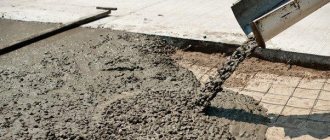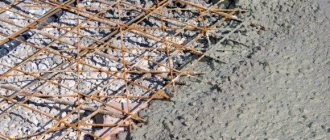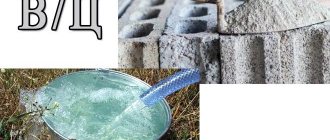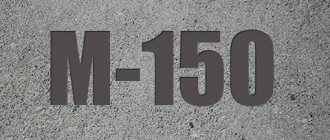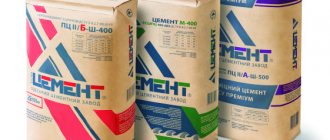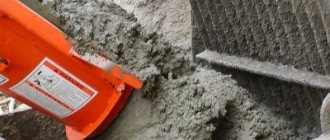Manufacturers, when indicating the price of concrete or concrete mixtures, usually describe the brand of concrete, strength class and filler material in their price lists. And sometimes you can find the following marking: M350 B25 P4 F200 W8 . How to understand the grades of concrete and the labeling of concrete mixtures will be discussed in this article.
Concrete and concrete mixture are essentially the same concepts. The only difference is that the concrete mixture is a mixed homogeneous mixture of binder (cement, etc.), aggregates (crushed stone, sand, etc.), water and additives. And concrete is already hardened concrete mixture .
New GOSTs (25192-2012, 7473-2010) oblige concrete producers to indicate the labeling of their concrete mixtures (BSG - ready-mix concrete, BSS - dry concrete mix). The main important properties of concrete are marked: grade (M), class (B), mobility (P), frost resistance (F) and water resistance (W).
Brand (M) and concrete class (B)
When purchasing concrete, the main focus is usually on the brand and class of concrete.
The numbers of the concrete grade (M200, M350, etc.) indicate (on average) the compressive strength in kgf/cm3. Compliance with the required parameters is checked by compression (with a special press) of cubes cast from a sample of concrete mixture and kept for 28 days. Relatively speaking, the higher the cement content in concrete, the stronger the concrete - therefore it is also generally accepted that the number after the letter M (from 50 to 1000) shows the cement content: concrete mixtures of grades M50 - M100 refer to types of concrete with a low cement content, and M500 -M600 – with high.
Correspondence of concrete grade to strength class:
| Concrete grade | Compressive strength class |
| M100 | B7.5 |
| M150 | AT 10 |
| M200 | B15 |
| M250 | IN 20 |
| M300 | B22.5 |
| M350 | B25 |
| M400 | B30 |
| M450 | B35 |
| M550 | B40 |
| M600 | B45 |
Concrete designation table
| Concrete strength class | The closest concrete grade in terms of strength | Application |
| B 3.5 | M 50 | |
| AT 5 | M 75 | |
| B 7.5 | M 100 | Preparatory work for pouring foundations. In road construction as a concrete cushion under curbs. |
| AT 10 | M150 | Floor screed, foundations for small structures, filling of paths in personal plots |
| At 12.5 | M 150 | |
| At 15 | M 200 | Various types of foundations (strip, slab), retaining walls, blind areas, stairs. One of the most popular concretes. |
| IN 20 | M 250 | The previous brand includes the production of fences and light-duty floor slabs. |
| At 22.5 | M 300 | Monolithic foundations, floor slabs, monolithic walls are added |
| At 25 | M 350 | Monolithic foundations, floor slabs, piles, road slabs, reinforced concrete products, swimming pool bowls. |
| At 27.5 | M 350 | |
| At 30 | M 400 | Hydraulic structures, bridges, specialized reinforced concrete products and structures. |
| At 35 | M 450 | Used in the construction of subways and dams. |
| At 40 | M 550 | It is rarely used and is produced according to specific requirements for each case. |
| At 45 | M 600 | |
| At 50 | M 700 | |
| At 55 | M 750 | |
| At 60 | M 800 | |
| At 65 | M 900 | |
| At 70 | M 900 | |
| At 75 | M 1000 | |
| At 80 | M 1000 |
Mobility (P)
Workability is a marking of the workability of a concrete mixture, calculated by the cone settlement (GOST 7473-2010)
Roughly speaking, the mobility of concrete is the ability of the mixture to fill the form in which it is placed, the ability to spread and occupy the given volume.
Mobility is determined experimentally. The concrete mixture is poured into a cone 30cm high. After removing the cone, the amount of sediment is measured. If the shape has remained practically unchanged (settled by 1-5 cm), then such concrete is called rigid. It hardly changes shape, but is perfectly formed using vibration compactors. The mobility of such concrete is low, and its use is limited: such a concrete mixture is difficult to install into formwork of a certain shape. Mixtures with sediment from 6cm to 12cm are classified as plastic types.
Concrete mix mobility categories:
| Mobility of concrete mixture | Cone draft |
| Sedentary (P1) | 1 – 5 cm |
| Mobile (P2) | 5 – 10 cm |
| Highly mobile (P3) | 10 – 15 cm |
| Cast (P4) | 15 – 20 cm |
| Fluid (P5) | 21 or more |
In practice, the mobility of concrete is often also referred to as plasticity or workability - i.e. how conveniently the mixture will fit into the mold and how quickly it will be taken, as well as what transport would be most appropriate for delivering concrete.
For ordinary monolithic work, concrete with mobility P3 is used. When pouring complex structures, it is better to order P4-P5. Mixtures with increased plasticity are faster and easier to take and place in formwork, without the use of a vibrator. In addition, it is convenient to pump plastic concrete mixtures with a concrete pump.
It is important to know: increasing the mobility of concrete is achieved by adding plasticizers at the factory, not water. Water can significantly degrade the quality of concrete.
Useful little things
- The easiest way to increase the mobility of concrete is to add water to it. However, its strength will suffer; This solution is only suitable for unloaded monoliths.
In general, it is better to use plasticizing additives.
- In addition to special additives - plasticizers, the price of which is sometimes quite immodest, to increase the mobility of the solution, a little (about a tablespoon per bucket) of liquid soap or dishwashing detergent is often added to it.
- Processing of load-bearing structures with dense reinforcement (in particular, cutting or drilling them) is extremely undesirable. Among other things, this disrupts the reinforcement that is supposed to be anchored along the edges of the opening. If damage to the reinforcement cannot be avoided for some reason, a compromise may be the use of corrugated reinforcement, diamond drilling of holes in concrete and cutting reinforced concrete with diamond wheels.
The corrugation of the reinforcement frame allows you to do without additional anchoring; Diamond cutting and drilling do not disrupt the adhesion between the reinforced frame and concrete due to the absence of impact vibration.
In addition: the edges of holes and openings when using a diamond tool will be much neater than when using a hammer drill and jackhammer.
The photo allows you to evaluate the quality of the cut edges.
Frost resistance (F)
Indicators of frost resistance of concrete reflect the number of freezing-thawing cycles that concrete can withstand (from 25 to 1000). Low frost resistance leads to a gradual decrease in load-bearing capacity and rapid surface wear of the concrete structure.
The main reason for the destruction of concrete under the influence of low temperatures is the expansion of water in the pores of the material when freezing. Those. Frost resistance mainly depends on the structure: the higher the volume of pores available for water, the lower the frost resistance.
Today, thanks to the use of special chemical additives (compacting, air-entraining, etc.), it is possible to create mixtures that can withstand ultra-low temperatures. Structural concretes M100, M150 are usually marked F50, and concretes M300, M350 - from F200.
Dependence of mobility on mixture composition
The mobility of concrete depends largely on the ratio of fillers. To change some characteristics, additives (plasticizers to increase fluidity) are introduced into the mixture. Ideal plasticity is obtained with the correct water-cement ratio. The more fillers and the lower the moisture content, the harder the mixture. An imbalance leads to a deterioration in the strength of the monolith. You cannot add water to a ready-made composition - this leads to undesirable separation of the mixture.
In general, the finished solution retains its characteristics unchanged for 2 hours after preparation. If longer storage or transportation is required, plasticizers are used that increase plasticity by up to 25%. The solution with plasticizer can be stored for up to 6 hours.
Waterproof (W)
Water resistance is the ability of concrete not to allow water to pass under pressure. In this case, the pressure is gradually increased until a certain value is reached, until water begins to leak out.
The water resistance of concrete is marked with the letter W and conventional units (the higher the value, the greater the water resistance). Industrial concrete mixtures have parameters from 2 to 20. Water resistance is one of the important characteristics of concrete, which opens up the possibility of using the mixture outdoors, in underground structures with high groundwater levels, etc. To increase the W value in concrete production, certain chemical additives or special cement (plasticized, etc.). In the building environment, concrete with high water resistance is also called hydraulic concrete.
What it is
The workability of concrete is a property that affects its ability to fill free-form formwork under the influence of its own weight. When applied to fluid mixtures, it is called mobility; For mixtures that are unable to spread under their own weight, another term is used - hardness.
It’s curious: the spreading of concrete and the spontaneous filling of the mold are prevented by the adhesion of filler particles to each other and to the walls of the mold; Moreover, the larger the particles, the greater the resistance. It is facilitated by a large amount of water, cement and special additives - plasticizers.
The presence or absence of pores in the thickness of the monolith depends on the mobility of the solution. The lack of mobility is partially offset by bayonet and/or vibration placement; however, they do not always allow you to get rid of cavities. Meanwhile, 2 percent of the volume occupied by pores will reduce the strength of the structure by 10%; increasing the cavity percentage to 5% will result in a 30% reduction in strength.
It would seem that the obvious solution would be to produce only and exclusively mixtures of high mobility: after all, they flow perfectly and do not require tedious bayoneting or energy-intensive vibratory laying. No such luck: sometimes excessive mobility is harmful.
Here are a couple of simple examples:
- Too mobile a mixture will pour out through the cracks of the board formwork.
- When laid on a crushed stone bedding, the moving concrete will not remain on its surface, but will go inside.
Excessively mobile mixture will go into crushed stone.
Concrete grade according to GOST 7473-94. Useful information about concrete.
When designing concrete and reinforced concrete structures, the required characteristics of concrete are assigned: concrete grade (strength class), frost resistance and water resistance grades.
The design grade of concrete for compressive strength is taken to be the axial compression resistance (kgf/cm2) of the reference cube samples. The design grade of concrete for axial tensile strength is the axial tensile resistance (kgf/cm2) of the control samples. This mark is assigned when it is of primary importance.
The frost resistance grade of concrete is characterized by the number of cycles of alternating freezing and thawing that the samples can withstand under standard test conditions. Designed for concrete exposed to repeated exposure to negative temperatures.
Stationary testing laboratory Mobile construction laboratory
The design grade of concrete for water resistance is characterized by one-sided hydrostatic pressure (kgf/cm2), at which concrete samples do not allow water to pass through under standard test conditions. Designed for concrete, which has requirements for density and water resistance.
The design grade of concrete for compressive strength is controlled by testing standard concrete samples: for monolithic structures at the age of 28 days, for prefabricated structures - within the time limits established for this type of product by the standard or technical specifications.
The design grade of concrete for monolithic structures can be installed with special justification at the age of 90 or 180 days, depending on the loading time, which allows saving cement.
The strength of concrete is determined by testing samples that are produced in batches; a series usually consists of three samples.
Tensile strength increases with increasing grade of concrete in terms of compressive strength, but the increase in tensile strength slows down in the area of high-strength concrete. Therefore, the tensile strength of concrete is 1/10-1/17 of the compressive strength, and the flexural strength is 1/6-1/10.
Concrete is produced by mixing cement, sand, crushed stone and water (their ratio depends on the brand of cement, fraction and moisture content of sand and crushed stone), as well as a small amount of additives (plasticizers, water repellents, etc.). Cement and water are the main binding components in the production of concrete. For example, when using 400 grade cement to produce 200 grade concrete, the ratio is 1:3:5:0.5. If grade 500 cement is used, then this conventional ratio produces concrete grade 350. The ratio of water and cement (“water-cement ratio”, “water-cement module”; denoted “W/C”) is an important characteristic of concrete. The strength of concrete directly depends on this ratio: the lower the W/C, the stronger the concrete. Theoretically, W/C = 0.2 is sufficient for cement hydration, but such concrete has too low plasticity, so in practice W/C = 0.3–0.5 are used.
A common mistake in artisanal concrete production is excessive addition of water, which increases the mobility of concrete, but reduces its strength several times.
Bibliography
| [1] | EN 12350-5:2000 | Testing of concrete mix - Part 5: Slurry test |
| (EN 12350-5:2000 | Testing fresh concrete - Part 5: Flow table test) | |
| [2] | EN 12350-4:2000 | Testing of concrete mixture - Part 4: Degree of compactability |
| (EN 12350-4:2000 | Testing fresh concrete - Part 5: Degree of compactibility) |
UDC 691.32:006.354 MKS 91.100.30 Zh13
Key words: concrete mixture, concrete mixture of a given quality, concrete mixture of a given composition, batch, workability grade, delamination, shelf life, volume of entrained air, customer, manufacturer (supplier), consumer
Application of concrete M200 (B15)
Concrete of this grade can be used during the following work:
1. In the process of pouring the foundation.
2. Pouring concrete for roads.
3. During construction of sites.
4. Production of reinforced concrete components, which are subsequently used for the construction of buildings and structures.
Also, building mixtures for brickwork can be produced on the basis of concrete grade B15.
Based on the standards (GOST 7473-94), class B 15 concrete has all the necessary characteristics that make it possible to use it in the following cases of need:
1. Pouring foundations for low-rise buildings (strip, pile-grillage, slab types).
2. Concreting various types of paths.
3. Filling retaining walls, etc.
4. Filling and leveling the floor covering.
5. Construction of interfloor openings, platforms, stairs, etc.
6. Production of reinforced concrete components for construction projects.
Moreover, grade B15 concrete will be an excellent choice when it is necessary to build a brick wall (brickwork).
Manufacturing proportions and strength gain of concrete mass
In order to produce a high-quality concrete mixture, it is necessary to take into account the purpose of the structure for which it is used. With a superficial approach to choosing the proportions of the mixture, you can get a very fragile material that is not suitable in terms of strength, water resistance, frost resistance or mobility. Or, on the contrary, get a high-class solution with high physical and mechanical properties, where this is not necessary. To produce concrete solutions that perform their functions, the following tables are used:
Composition and proportions of concrete from cement
Concrete does not acquire all its qualities in those 2-3 days when it already seems absolutely solid. In the first week after pouring, the mixture acquires 70% of its strength.
The material reaches brand strength on the 28th day after installation. At the same time, the strength gain does not stop after 28 days. Within three years after pouring, the structure can reach 300% relative strength at 28 days. He becomes very strong.
To estimate the rate at which concrete masses gain strength, use the following graph:
Concrete strength gain schedule
When building your own home, you can always hire specialists who will do everything for you at home. If you have some knowledge, you can always prepare lightweight concrete with your own hands or evaluate its quality without missing out on the details.
Hardness (W)
The stiffness of a concrete mixture is characterized by the vibration time required to level and compact the preformed cone of the concrete mixture in a stiffness tester. Measured in seconds.
Hardness grades according to GOST 7473-2010):
| Brand | Hardness, s |
| Zh1 | 5-10 |
| Zh2 | 11-20 |
| Zh3 | 21-30 |
| Zh4 | 31-50 |
| Zh5 | More than 50 |
That is, the more time it takes to compact concrete, the harder it becomes: Zh 5 is the hardest, Zh1 is the least hard.
According to GOST 747Z-94
(which some manufacturers are still focusing on), it is permissible to use the following classification: according to workability, concrete was divided into: flexible (P), rigid (R) and super-rigid (SH).
| Brand | Hardness, s |
| Super-hard mixtures | |
| SZh3 | More than 100 |
| SZh3 | 51-100 |
| SZh3 | Less than 50 |
| Hard mixtures | |
| Zh4 | 31-60 |
| Zh3 | 21-30 |
| Zh2 | 11-20 |
| Zh1 | 5-10 |
| Mobile mixtures | 4 or less |
Return to section


